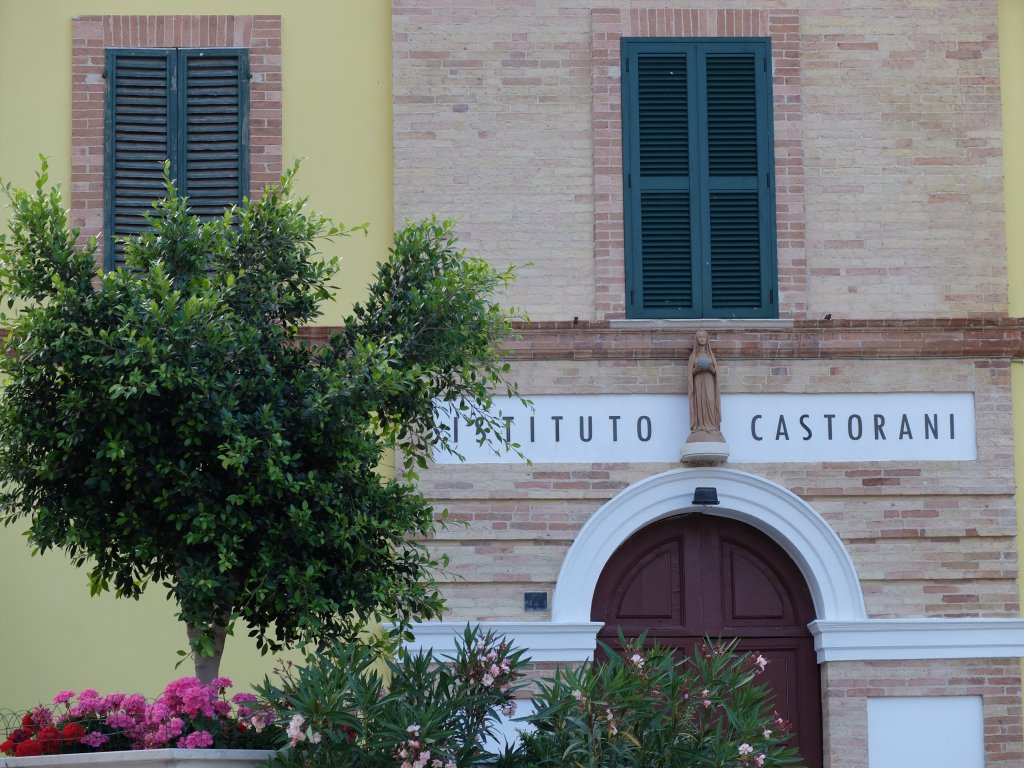- Home
- Punti di interesse
- Contrada di San Rocco: l'antico ospedale con la chiesa di San Rocco e piazza Caduti 1944
Descrizione
La Contrada di San Rocco si trovava nella parte settentronale della città, vicina alla cinta di mura di Giulia.
Il largo alle spalle del palazzo municipale, è venuto a formarsi a seguito dell’esplosione di una bomba lanciata dalla flotta aerea alleata il 29 febbraio 1944. L’esplosione rase al suolo le abitazioni che qui sorgevano, provocando decine di vittime e segnando per sempre la Contrada di San Rocco.
Lungo un lato della piazza sorge il complesso di San Rocco, patrono degli appestati, che ingloba l’omonima chiesa. Fin dalla fondazione della città alla fine del Quattrocento, l’area in cui siamo, un tempo non lontano dall’imbocco della Porta da capo o Santa Maria, è stata destinata ad ospitare il lazzaretto. Un antico ospedale infatti sorgeva nel distrutto centro medievale di Castel San Flaviano. Alla chiesa di San Rocco che aveva il suo ingresso verso l'attuale piazza, si addossava da un lato la chiesa-oratorio della Confraternita della Misericordia, costruito almeno dal Cinquecento, e dall'altro lato i locali di ricovero per malati e pellegrini.
Nel 1869 la struttura venne modificata e si aggiunsero un asilo e una scuola affidati all’ordine delle Figlie della Carità. A causa dei lavori, il tratto di mura retrostante venne distrutto. Il complesso è dedicato al medico Raffaele Castorani, direttore della Clinica Oftalmica dell’Università di Napoli nell’Ottocento.
----ENG----
The district San Rocco was located in the northern part of the city, near the walls of Giulia.
The open space behind the town hall was created after a bomb exploded on February 29, 1944, dropped by the allied air fleet. The blast destroyed homes, dozens of people died and the San Rocco neighborhood was marked forever.
On one side of the square stands the complex of San Rocco, patron saint of plague victims, surrounding the church of the same name. Since the founding of the city at the end of the fifteenth century, the area we are in, not far from the entrance of the "Porta da Capo" or "Santa Maria", was destined to house the hospital. An old hospital actually stood in the medieval center of Castel San Flaviano. On one side of the church of "San Rocco", which had its entrance in the current square, was the oratory church of the Brotherhood "della Misericordia", built at least in the sixteenth century, on the other side the rooms of the sick and pilgrims.
In 1869 the structure was modified and a kindergarten and a school were added, entrusted to the Order of “Figlie della Carità”. The section of wall behind was destroyed by the work. The complex is dedicated to the doctor Raffaele Castorani, director of the University of Naples Eye Clinic in the 19th century.
----DE----
Das Quartier San Rocco: das alte Krankenhaus mit der Kirche „San Rocco“ und Platz der Gefallenen 1944
Beschreibung
Das Quartier San Rocco befand sich im nördlichen Teil der Stadt, in der Nähe der Stadtmauern von Giulia.
Der offene Platz hinter dem Rathaus entstand nach der Explosion einer Bombe, die am 29. Februar 1944 von der alliierten Luftflotte abgeworfen wurde. Bei der Explosion wurden die Häuser zerstört, es gab Dutzende von Opfern und das Quartier San Rocco wurde für immer gezeichent.
An einer Seite des Platzes steht der Komplex von San Rocco, Schutzpatron der Pestopfer, der die gleichnamige Kirche umgibt. Seit der Gründung der Stadt Ende des fünfzehnten Jahrhunderts war die Zone, in der wir uns befinden, einst nicht weit vom Eingang der „Porta da Capo“ oder „Santa Maria“ entfernt, dazu bestimmt, das Krankenhaus zu beherbergen. Ein altes Krankenhaus stand tatsächlich im mittelalterlichen Zentrum von Castel San Flaviano. Auf der einen Seite der Kirche von „San Rocco“, die ihren Eingang zum heutigen Platz hatte, war die Oratoriumskirche der Bruderschaft „della Misericordia“, mindestens im sechzehnten Jahrhundert erbaut, auf der anderen Seite die Räumlichkeiten der Kranken und Pilger.
1869 wurde die Struktur geändert und ein Kindergarten und eine Schule wurden hinzugefügt, die dem Orden „Figlie della Carità“ anvertraut wurden. Durch die Arbeiten wurde der dahinter liegende Mauerabschnitt zerstört. Der Komplex ist dem Arzt Raffaele Castorani gewidmet, der im 19. Jahrhundert Direktor der Augenklinik der Universität von Neapel war.

